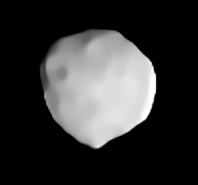324 Bamberga facts for kids

VLT image of Bamberga
|
|
| Discovery | |
|---|---|
| Discovered by | Johann Palisa |
| Discovery date | 25 February 1892 |
| Designations | |
| MPC designation | (324) Bamberga |
| Pronunciation | bam-BUR-gə |
|
Named after
|
Bamberg |
| Main belt | |
| Orbital characteristics | |
| Epoch 31 July 2016 (JD 2457600.5) | |
| Uncertainty parameter 0 | |
| Observation arc | 124.08 yr (45321 d) |
| Aphelion | 3.59442 AU (537.718 Gm) |
| Perihelion | 1.77023 AU (264.823 Gm) |
| 2.68232 AU (401.269 Gm) | |
| Eccentricity | 0.34004 |
| 4.39 yr (1604.6 d) | |
| 225.419° | |
|
Mean motion
|
0° 13m 27.682s / day |
| Inclination | 11.1011° |
| 327.883° | |
| 44.2409° | |
| Physical characteristics | |
| Dimensions | 229.44±7.4 km 234.67 ± 7.80 km 229.4 ± 7.4 km (IRAS) |
| Mass | 1.1×1019 kg (1.03 ± 0.10) × 1019 kg |
|
Mean density
|
1.52 ± 0.20 g/cm3 |
| 1.226 d 29.43 h (1.226 d) |
|
| 0.0628±0.004 0.0628 |
|
| C-type asteroid | |
| 6.82 | |
324 Bamberga is a large asteroid found in the Main Asteroid Belt. It is the 16th biggest asteroid known in this region.
It was discovered by Johann Palisa on February 25, 1892, in Vienna. Bamberga was one of the last very large asteroids (over 200 kilometers wide) to be found. It was also one of the last asteroids that can be easily seen with binoculars.
Brightness and Orbit
Bamberga's orbit is quite stretched out, which astronomers call having a high "eccentricity." This means its brightness changes a lot depending on where it is in its path around the Sun.
When Bamberga is closest to the Sun (at a point called "perihelion") and also closest to Earth, it can become very bright. It can reach a magnitude of +8.0. This is about as bright as Saturn's moon Titan.
These very bright moments happen about every 22 years. The last time was in 1991, and the next was in 2013. During these times, Bamberga is the brightest type of asteroid known as a "C-type asteroid." It shines brighter than 10 Hygiea, another large C-type asteroid.
At its brightest, Bamberga can get closer to Earth than almost any other large asteroid in the main belt. It can be as close as 0.78 AU (about 116 million kilometers). For comparison, 4 Vesta, which is sometimes visible to the naked eye, never gets closer than 1.13 AU.
Comparing Asteroids
Overall, Bamberga is the tenth brightest asteroid in the main belt. It is not as bright as Vesta, Pallas, or Ceres. Other brighter asteroids include Iris, Hebe, Juno, Melpomene, Eunomia, and Flora.
Because of its unusual orbit, Bamberga is not always the brightest. Most of the time, other asteroids appear brighter in the sky.
Features of Bamberga
Bamberga spins quite slowly compared to other large asteroids. It takes about 29.43 hours to complete one full rotation.
Scientists classify asteroids by their "spectral type," which tells us about their surface materials. Bamberga is a mix between a C-type and a P-type asteroid. C-type asteroids are usually dark and carbon-rich.
In 1987, scientists observed Bamberga passing in front of a distant star. This event is called an "occultation." By watching how the star's light dimmed, they could measure Bamberga's size. They found it was about 228 kilometers wide, which matched other measurements.
Images for kids
See also

- (324) Bamberga para niños (in Spanish)


